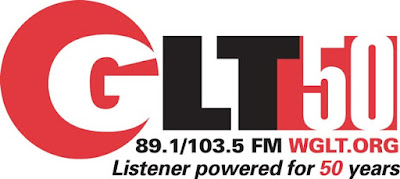Three very
successful public radio organizations are celebrating many years of public
media service this year. WGLT, Normal/Bloomington is the oldest-timer of the
bunch, turning 50 this year. WUNC, Chapel Hill is marking 40 years and New
Hampshire Public Radio has 35 candles on the cake.
Anniversaries like
these are reminders of the legacy of public broadcasting and a caution to
remain diligent in the fast moving media landscape. The three organizations
have become “content factories,” serving their communities with on multiple platforms.
WGLT: BRINGING NEWS, JAZZ & IDEAS TO
CENTRAL ILLINOIS
I’ve always had a special
interest in WGLT because of family connection to Illinois State University. My
grandfather was a math and astronomy professor at ISU for many years. I spent
parts of several summers there when I was a kid enjoying Steak ‘n Shake, the
Castle Theater (where my dad worked with his friend McLean Stevenson of M*A*S*H
fame) and the rolling hills of Miller Park. Radio, back in those days meant
WJBC or my favorite WLS from Chicago.
WGLT [link] signed
on in 1966. For the first few years it
was a student station. In the mid 1970s WGLT became part of National Public
Radio, one of the first Illinois members of NPR. Like many public radio
stations of that era, WGLT had a checkerboard schedule of local talk shows, blocks
of jazz and classical, plus coverage of the ISU Redbird football, basketball
and baseball games.
 |
| Bruce Bergethon |
Then Bruce Bergethon
entered the picture. He brought WGLT into modern times.
Bergethon became
WGLT’s manager in 1990. During his 25 years leading WGLT (he retired in 2015) the
station focused it’s programming on NPR News and Jazz music, upgraded the
Bloomington signal to maximum power, added a signal to serve Peoria and resolved
several major financial challenges. Way to go, Bruce.
_________________
WUNC CELEBRATES ITS 40th
ANNIVERSARY ON SEPTEMBER 10th WITH A PARTY
 |
| KEN MILLS PRI 1994 |
I visited WUNC
twice during the time I was Director of News at Public Radio International
(PRI). Execs at PRI split up the chore of participating in regional station
meetings. WUNC was part of North
Carolina Public Radio and attending its meetings were not most folks first choice,
so they sent me and I loved it, particularly Chapel Hill. My most vivid memory was when I was at the
old office/studio location. My guide,
Kevin Wolfe I believe, showed me WUNC’s back up power source: The world’s
largest “D cell” battery.
Somehow after WWII
UNC acquired the hugest battery I have ever seen. It took up an entire room and
looked like a prop in a sci-fy flick. I
recall saying to Wolfe At least it is
portable!
WUNC celebrates its
first 40 years with a festival on Saturday, September 10th from 2pm
– 6pm at the Koka Booth Amphitheatre in suburban Cary. The event will feature
live music, food trucks and children’s activities. Chatham County Line and the Red
Clay Ramblers are scheduled to perform. “WUNC Personalities” will also be
there no doubt singing and dancing. More information is at [link].
_______________
NEW HAMPSHIRE PUBLIC RADIO HAS BECOME A
REGIONAL NEWS SOURCE
In 1981, what
became New Hampshire Public Radio (NHPR) started as one station: WEVO in Concord.
At the time, they called it Granite State
Public Radio. In 1983 they faced their first existential crisis at around
the same time as the NPR crisis. Because NHPR was/is an unaffiliated community
licensee, they turned to their members. More than 1,000 good folks stepped up
and pledged enough support to keep WEVO on the air. Though NHPR’s finances are
more stable now, that same spirit is still present.
Under the wise
leadership of General Manager Mark Handley in 1991 they officially became New Hampshire Public Radio and built a
statewide network of repeater stations and translators.
During Handley’s
tenure NHPR invested in locally originated programming beginning with a daily
talk/interview show hosted by Keene native and NPR newscaster, Laura Knoy. The
show became The Exchange and it is
now NHPR’s flagship program.
Read a fascinating
complete history of NHPR at [link].
























